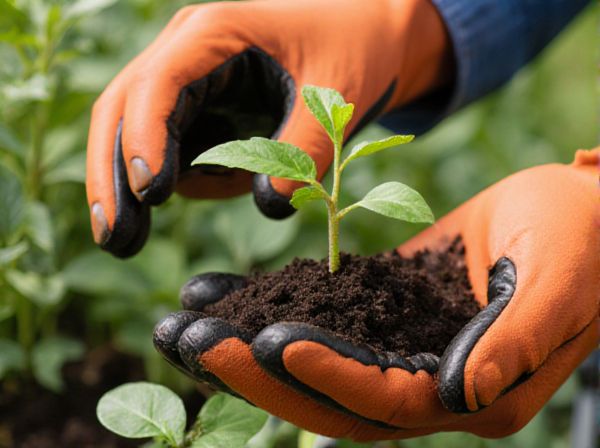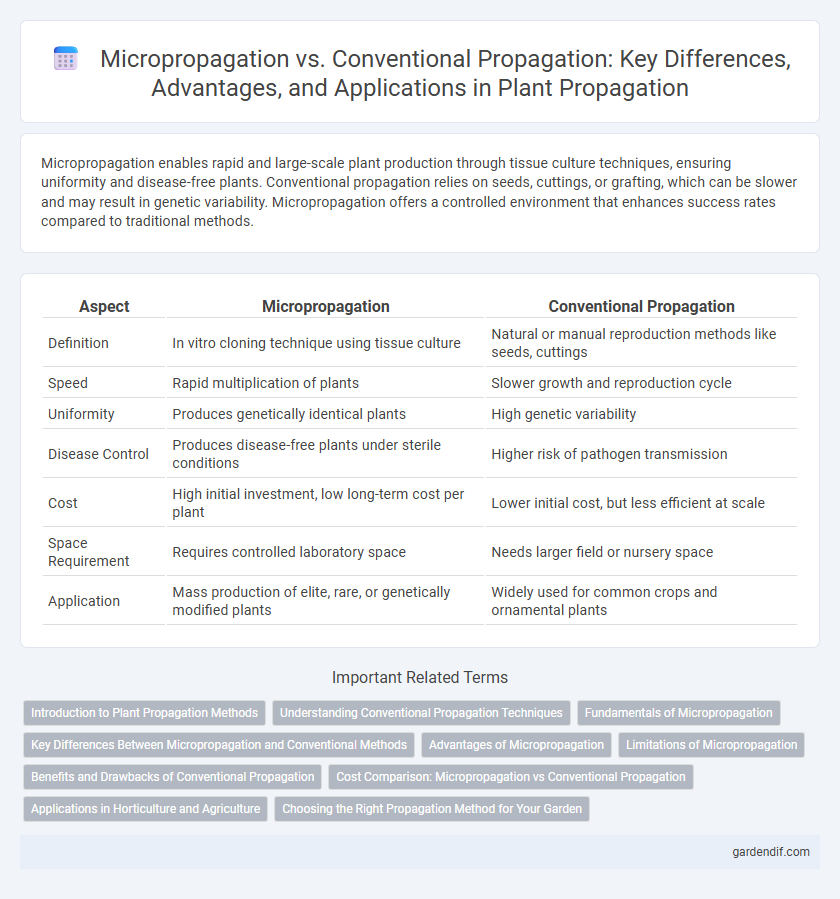
Micropropagation vs Conventional propagation Illustration
Micropropagation enables rapid and large-scale plant production through tissue culture techniques, ensuring uniformity and disease-free plants. Conventional propagation relies on seeds, cuttings, or grafting, which can be slower and may result in genetic variability. Micropropagation offers a controlled environment that enhances success rates compared to traditional methods.
Table of Comparison
| Aspect | Micropropagation | Conventional Propagation |
|---|---|---|
| Definition | In vitro cloning technique using tissue culture | Natural or manual reproduction methods like seeds, cuttings |
| Speed | Rapid multiplication of plants | Slower growth and reproduction cycle |
| Uniformity | Produces genetically identical plants | High genetic variability |
| Disease Control | Produces disease-free plants under sterile conditions | Higher risk of pathogen transmission |
| Cost | High initial investment, low long-term cost per plant | Lower initial cost, but less efficient at scale |
| Space Requirement | Requires controlled laboratory space | Needs larger field or nursery space |
| Application | Mass production of elite, rare, or genetically modified plants | Widely used for common crops and ornamental plants |
Introduction to Plant Propagation Methods
Micropropagation uses tissue culture techniques to produce large numbers of genetically identical plants quickly, ensuring uniformity and disease-free stock. Conventional propagation relies on seeds, cuttings, grafting, or layering, which can result in slower multiplication and variable offspring quality. Understanding the differences in these plant propagation methods is crucial for optimizing plant production and improving crop yield.
Understanding Conventional Propagation Techniques
Conventional propagation techniques include seed sowing, cuttings, grafting, layering, and division, essential for generating genetically diverse plants and maintaining traditional horticultural practices. These methods rely on natural reproductive processes, often resulting in slower multiplication rates and greater environmental dependency compared to micropropagation. Understanding the principles of conventional propagation aids in selecting appropriate techniques for specific crops and enhances adaptability in varying agricultural conditions.
Fundamentals of Micropropagation
Micropropagation relies on aseptic tissue culture techniques to produce multiple genetically identical plants from a single explant, enhancing uniformity and disease resistance. This method uses controlled environments and nutrient media to stimulate rapid cell division through stages such as initiation, multiplication, rooting, and acclimatization. Unlike conventional propagation, which depends on seeds or cuttings and is limited by breeding cycles and environmental factors, micropropagation ensures consistent quality and scalability in plant production.
Key Differences Between Micropropagation and Conventional Methods
Micropropagation uses tissue culture techniques to produce thousands of genetically identical plants rapidly under sterile conditions, while conventional propagation relies on seeds, cuttings, or grafting with slower multiplication rates and more genetic variability. Micropropagation allows year-round production unaffected by seasonal changes, whereas conventional methods depend on environmental factors and longer growth cycles. The precise control in micropropagation minimizes disease transmission, contrasting with the higher risk of pathogens in conventional propagation.
Advantages of Micropropagation
Micropropagation offers rapid multiplication of disease-free plants with uniform genetic traits, significantly outpacing conventional propagation methods. This technique ensures year-round production irrespective of seasonal limitations and requires less space, reducing nursery costs substantially. Enhanced control over environmental conditions during micropropagation results in higher survival rates and consistent quality of plantlets compared to traditional propagation.
Limitations of Micropropagation
Micropropagation faces limitations such as high initial setup costs, the need for specialized laboratory facilities, and risks of somaclonal variation affecting genetic stability. Unlike conventional propagation, it requires skilled technicians and strict sterile conditions to prevent contamination. Moreover, scaling micropropagation for large-scale production can be challenging due to labor-intensive processes and dependence on controlled environments.
Benefits and Drawbacks of Conventional Propagation
Conventional propagation offers benefits such as simplicity, low cost, and the ability to produce plants true to type from seeds or cuttings, making it accessible for gardeners and farmers without specialized equipment. However, it faces drawbacks including slower multiplication rates, susceptibility to diseases transmitted through seeds or cuttings, and less control over environmental conditions, which can result in variable plant quality and lower uniformity. These limitations contrast with micropropagation's rapid, large-scale production and disease-free plantlets, highlighting conventional methods' challenges in commercial-scale applications.
Cost Comparison: Micropropagation vs Conventional Propagation
Micropropagation typically involves higher initial costs due to sterile laboratory conditions, specialized equipment, and skilled labor, whereas conventional propagation methods such as cuttings or seed sowing require lower investment in basic tools and natural growing environments. Over time, micropropagation can reduce production costs by accelerating plant multiplication rates and producing disease-free, uniform plants that improve yield quality and market value. Conventional propagation remains more cost-effective for small-scale growers or species with high germination or rooting success but lacks the scalability and precision of micropropagation in commercial horticulture.
Applications in Horticulture and Agriculture
Micropropagation enables rapid clonal propagation of disease-free plants, making it ideal for large-scale commercial horticulture and agriculture, especially for high-value crops like orchids, bananas, and potatoes. Conventional propagation methods, such as seed sowing and cuttings, remain essential for crops with simpler reproductive cycles and metal-tolerant species adapted to local environments. Micropropagation's precision and scalability strongly benefit breeding programs, germplasm conservation, and mass production of uniform planting material, accelerating crop improvement efforts.
Choosing the Right Propagation Method for Your Garden
Micropropagation offers rapid multiplication of disease-free plants through tissue culture, ideal for producing large quantities of uniform specimens. Conventional propagation methods like seeds and cuttings provide genetic diversity and are often more cost-effective for hobbyist gardeners. Selecting the right propagation method depends on factors such as desired plant uniformity, scale of production, available resources, and time constraints in your garden.
Micropropagation vs Conventional propagation Infographic

 gardendif.com
gardendif.com